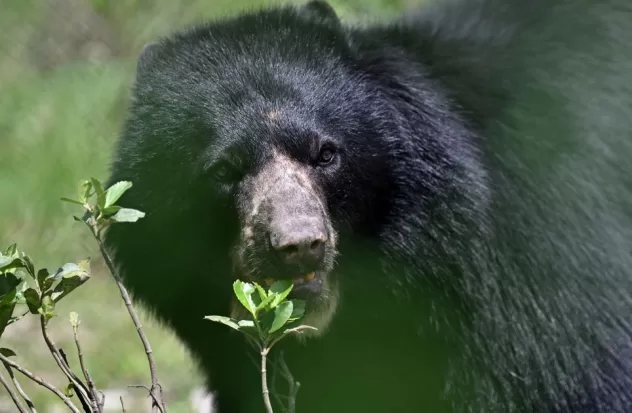Guasca, Colombia.- Tamá’s caregivers know that they are not facing a andean bear any. Black, with a white mask and weighing 174 kilos, the animal is considered an “escapist” for escaping from a Zoo outside Bogotá in 2022.
The eight-year-old unruly bear was heard. Today a team of biologists and veterinarians are preparing him for an eventual return to the forests of the Colombian Andes.
“With that escape, Tamá showed us many things, like her desire to be free.. We are giving him that second chance,” Orlando Feliciano, the veterinarian who received him when he was a five-month-old orphaned bear cub, tells AFP.
“We received him by air and he arrived dying in a basket (…) he was absolutely anemic, with a flea infestation,” recalls Feliciano.
Dedicated for two decades to the conservation of the condor and the Andean bear, his face is weathered by the sun and the cold wind of the Chingaza moor (center), a high mountain ecosystem on the outskirts of the capital of Colombia.
According to expert calculations, about 130 Andean bears live there.a species in a vulnerable state of conservation, according to the International Union for Conservation of Nature.
Feliciano named the animal after the natural park where farmers found it abandoned, near the border with Venezuela, and finished raising it.
Years later, the animal took advantage of damage to one of the fences of the zoo where it was kept and escaped, unleashing a two-week media chase up a hill on the outskirts of Bogotá.
Satellite monitoring
Tamá is preparing to return to the wild at the Spectacled Bear Sanctuary, a preservation site closed to the public where Feliciano receives animals seized or found in poor conditions.
In this space, reopened this week after a renovation that improved its facilities, Feliciano maintains four individuals of the species.
Among them a couple of orphaned brothers, raised by a peasant family. Unlike Tamá, they are gentle bears and from their cage – a large, but fenced space – they come to greet their caretaker. They have no chance of surviving the wild.
Tamá, the only one with any prospect of liberation, remains in a separate fence. Elusive and shy, it spends most of the day hidden in 7,500 square meters of thick vegetation.
“It is being monitored with a satellite telemetry collar, we already know that it is an escapist,” explains Daniel Rodríguez, a biologist at the Wii Foundation, which also protects this species distributed from Venezuela to Bolivia.
“The devil” appeared
In September 2022, a tree fell at the Jaime Duque Zoo, about 20 kilometers from Bogotá, and partially damaged Tamá’s cage.
“He managed to find the hole, finished opening it and left,” recalls Rodríguez, who participated in the search for the fugitive bear.
He was surprised that this captive-bred animal knew how to climb trees and mark them with its claws. He also preferred bromeliads – his natural diet – to the foods left out by zoo staff to attract him.
“We realized that it had a chance of survival in the forest,” concludes the biologist.
Residents of the area also had surprises.
“A peasant told us that he had seen it and thought it was the devil (…) who had appeared to him due to his bad behavior,” Feliciano recalls with a laugh.
Finally Tamá fell into a trap with food and returned with Feliciano to the Sanctuary, where he spent most of his youth.
Human threat
In the absence of natural predators, the Andean bear occasionally comes into conflict with ranchers who have been moving closer and closer to its natural habitat, punished by deforestation.
“When the bear goes through a small, fragmented forest, with little natural food and encounters a cow, it is as if they gave me a piece of meat,” explains Feliciano.
Although the species has a mainly herbivorous diet, there are numerous reports of attacks on livestock. Also of bears hunted in retaliation.
That is why specimens prone to approaching humans cannot be released. In the case of Tamá, the final say lies with the local environmental authority and the residents of Chingaza, who must give approval for its release.
Although they do not risk setting a date, Rodríguez and Feliciano agree that Tamá shows signs of being ready to return to his habitat.
“Although it has the care and food here (…) this is not the place for a bear,” acknowledges the owner of the Sanctuary.
“It is not fair that an animal of these characteristics lives in a space of 7,500 square meters,” he concludes.
Source: afp


